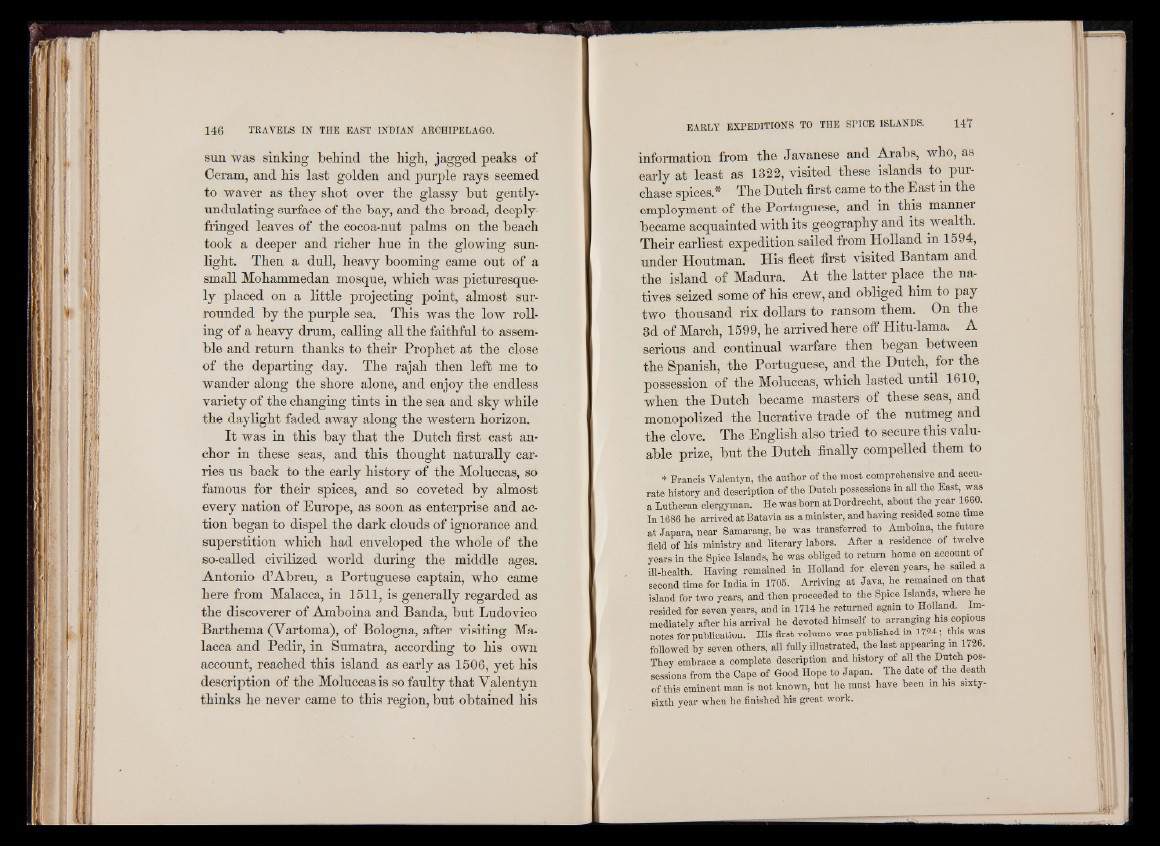
sun was sinking behind the high, jagged peaks of
Ceram, and his last golden and purple rays seemed
to waver as they shot over the glassy but gently-
undulating surface of the bay, and the broad, deeply-
fringed leaves of the cocoa-nut palms on the beach
took a deeper and richer hue in the glowing sunlight.
Then a dull, heavy booming came out of a
small Mohammedan mosque, which was picturesquely
placed on a little projecting point, almost surrounded
by the purple sea. This was the low rolling
of a heavy drum, calling all the faithful to assemble
and return thanks to their Prophet at the close
of the departing day. The rajah then left me to
wander along the shore alone, and enjoy the endless
variety of the changing tints in the sea and sky while
the daylight faded away along the western horizon.
It was in this bay that the Dutch first cast anchor
in these seas, and this thought naturally carries
us back to the early history of the Moluccas, so
famous for their spices, and so coveted by almost
every nation of Europe, as soon as enterprise and action
began to dispel the dark clouds of ignorance and
superstition which had enveloped the whole of the
so-called civilized world during the middle ages.
Antonio d’Abreu, a Portuguese captain, who came
here from Malacca, in 1511, is generally regarded as
the discoverer of Amboina and Banda, but Ludovico
Barthema (Vartoma), of Bologna, after visiting Malacca
and Pedir, in Sumatra, according to his own
account, reached this island as early as 1506, yet his
description of the Moluccas is so faulty that Valentyn
thinks he never came to this region, but obtained his
information from the Javanese and Arabs, who, as
early at least as 1322, visited these islands to purchase
spices.* The Dutch first came to the East in the
employment of the Portuguese, and in this manner
became acquainted with its geography and its wealth.
Their earliest expedition sailed from Holland in 1594,
under Houtman. His fleet first visited Bantam and
the island of Madura. At the latter place the natives
seized some of his crew, and obliged him to pay
two thousand rix dollars to ransom them. On the
3d of March, 1599, he arrived here off Hitu-lama. A
serious and continual warfare then began between
the Spanish, the Portuguese, and the Dutch, for the
possession of the Moluccas, which lasted until 1610,
when the Dutch became masters of these seas, and
monopolized the lucrative trade of the nutmeg and
the clove. The English also tried to secure this valuable
prize, but the Dutch finally compelled them to
* Francis Valentyn, the author of the most comprehensive and accurate
history and description of the Dutch possessions in all the East, was
a Lutheran clergyman. He was born at Dordrecht, about the year 1660.
In 1686 he arrived at Batavia as a minister, and having resided some time
at Japara, near Samarang, he was transferred to Amhoina, the future
field of his ministry and literary labors. After a residence of twelve
years in the Spice Islands, he was obliged to return home on account of
ill-health. Having remained in Holland for eleven years, he sailed a
second time for India in 1705. Arriving at Java, he remained on that
island for two years, and then proceeded to the Spice Islands, where he
resided for seven years, and in 1714 he returned again to Holland. Immediately
after his arrival he devoted himself to arranging his copious
notes for publication. His first volume was published in 1724 ; this was
followed by seven others, all fully illustrated, the last appearing in 1726.
They embrace a complete description and history of ail the Dutch possessions
from the Cape of Good Hope to Japan. The date of the death
of this eminent man is not known, hut he must have been in his sixty-
sixth year when he finished his great work.